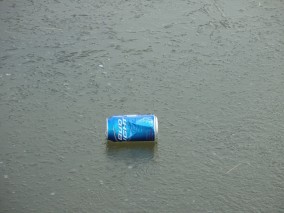Winter waste management
- Article Published At:
- Rutland Herald
- Date of Publication:
- March 7th, 2010
As I walk down to the covered bridge every morning in winter, I see many items that have been thrown from car windows into the flood plain of the Otter Creek. There is a banana skin, now blackened and freeze- dried, which by spring will have crumbled away. There must be a dozen aluminum beer cans that have been tossed out. Every now and then one gets flattened by a passing car. These cans took a lot of energy to make, and it will be years before they oxidize and return to the earth. There are many plastic bottles, some still intact that will float away on the spring flood, and perhaps a few will eventually join the plastic rubble that is filling our distant oceans.
Winter is recovery and cleanup time for the biosphere. Many creatures have to hide deep in the earth to survive the cold, which kills off many pests. Cold winters across the Rocky Mountains used to kill the pine beetles, but as minimum temperatures rise, more beetles survive and pine forests are dying even up into Canada.
But winter cannot clean up our industrial waste.
In my last column, I talked about the need to extend our time-frame of reference — if we are to accommodate the needs of the Earth's biosphere. Cooperating with the Earth requires another fundamental shift.
When human beings were few in number and our industrial production small, the Earth could absorb our waste products. Yes, from time to time we overstressed a region's resources, and a civilization fell — but people moved on, and humanity prospered elsewhere.
Now, however, the global population, at our present levels of consumption and waste production, exceeds the carrying capacity of this planet. We cannot move on, so we face the collapse of the human system on a grand scale, unless we wake up and get smarter. There are several issues here. One is that we must stabilize and then reduce the global population, a process that will take generations. The second, immediate issue is that we need to minimize the lifetime of all the waste products from human industrial society in the earth system. This is essential, because of the global scale of our impacts — and it can be done more quickly, on a decadal time-scale, simply by replacing manufacturing infrastructure.
How do we manage the Earth, when there is so much we don't know? Here are a few simple rules we must follow to be responsible caretakers:
All our waste products must have short lifetimes in the biosphere.
We must minimize the use of raw materials by recycling for remanufacture.
We must maximize the efficiency with which we use energy and water.
You know many examples of long-lived waste. The CFCs (chlorofluorocarbons) were wonderful, stable refrigerants, until we found out that their final breakdown in the stratosphere destroyed the ozone, which protects life from harmful ultraviolet rays. It will take decades to get them out of old refrigerators and out of the atmosphere. And carbon dioxide, coming largely from burning so much fossil fuel, is accumulating in the atmosphere. We didn't think that would be a problem, but the Earth's climate will warm for a century or more. We knew nuclear weapons were a disaster, but we have kept building nuclear power plants that make plutonium, which may be with us as bomb material for tens of thousands of years.
So bundle up and notice the garbage by our roadsides that will outlive you. Of course it wasn't you that tossed it. But since we as a species can't manage our waste responsibly, we need to stop making it in the first place.
Caretaking this precious Earth is necessary — it will take a patient, creative and joyful rebuilding of our society.
Related Topics
Figures and Images
 Figure 1: Winter Trash in floodplainBeer can thrown from car onto frozen flood plain
Figure 1: Winter Trash in floodplainBeer can thrown from car onto frozen flood plain